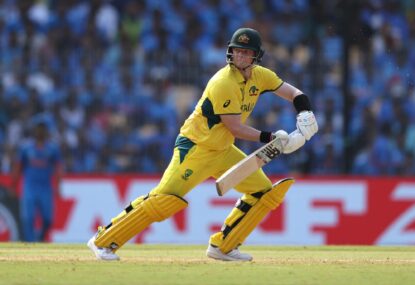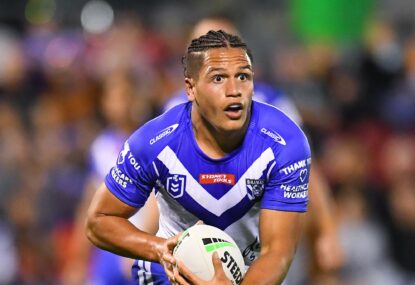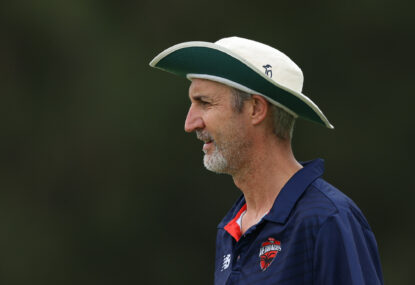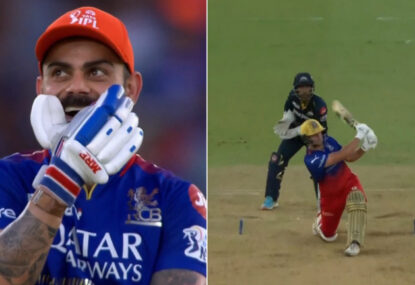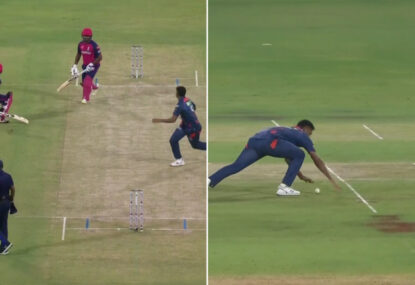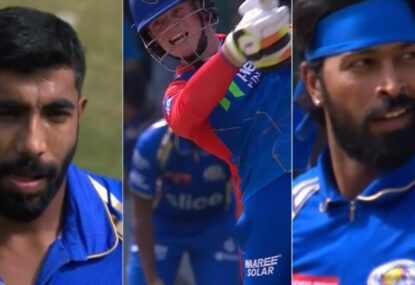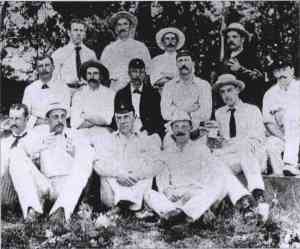
F Hearne (back, third from left) with the 1888/9 England team that played in the first Test at Port Elizabeth,
Cricket has produced more well-known families than any other sport. From 1877, when Test cricket started, until now, the game has been dominated by notable families.
The Graces; Gregories; Bannermans; Hearnes; Fosters; Tyldesleys; Nourses; Pataudis; Benauds; Mohammads; Chappells; Hadlees; Headleys; Amarnaths; Pollocks; Khans… right down to the Waugh twins and the Flower power.
The Roar presents a 4-part feature on cricketing families. The input of Roarers will be appreciated.
Inaugurated 132 years ago, Test cricket is in its fifth generation. Amazingly, the first 100 years were covered by a single family.
William Cooper played his first Test for Australia in December 1881 and his great-grandson Paul Sheahan, the elegant batsman and superb fielder, played the last of his 31 Tests for Australia in January 1974.
Dean Headley created history when he made his Test debut for England against Australia at Manchester in 1997. It was the first instance of three direct generations of Test cricketers.
Dean’s father, Ron, had represented the West Indies in 1973 and his grandfather, the legendary George (nicknamed ‘Black Bradman’), had played for the Windies from 1929 to 1953 with distinction.
There is only one subsequent instance of three direct generations in Test history.
Bazid Khan is the son of Majid Khan and nephew of Imran Khan and the grandson of Jahangir Khan. Bazid and Majid represented Pakistan and grandpa Jahangir, India.
The Mohammads have produced four brothers – Wazir, Hanif, Mushtaq and Sadiq – who represented Pakistan. Hanif’s son Shoaib also played 45 Tests. Between them, they made 218 Test appearances; a record which the Waugh twins Steve and Mark broke in the new millennium by playing a total of 296 Tests.
India’s Lala Amarnath and New Zealander Walter Hadlee are the only Test cricketers to sire two sons each who went on to play Test matches.
Most family members to play in Test cricket:
Six: Brothers GG, F and A Hearne, their cousin JT Hearne and his cousin JW Hearne played for England. F Hearne and his son GAL Hearne played for South Africa.
Six: M Jahangir Khan and brother-in-law Baqa Jilani played for India. Jahangir’s son Majid Khan, nephews Javed Burki and Imran Khan and grandson Bazid Khan (Majid’s son) played for Pakistan.
Five: Brothers EJ and DW Gregory, EJ’s son SE Gregory, nephew JM Gregory and ES’s brother-in-law H. Donnan played for Australia.
Five: Four Mohammad brothers Wazir, Hanif, Mushtaq and Sadiq, and Hanif’s son Shoaib Mohammad played for Pakistan. (A fifth brother, Raees Mohammad, narrowly missed out. He was made 12th man for Pakistan against India in the 1955 Dacca Test).
List of three generations of Test cricketers:
Great-grandfather and Great-grandson –
WH Cooper (Australia, 2 Tests, 1881- 85); AP Sheahan (Australia, 31 Tests, 1967 – 1974).
Grandfather, Father and Son –
GA Headley (West Indies, 22 Tests, 1929-53); RGA Headley (West Indies, 2 Tests, 1973); DW Headley (England, 15 Tests, 1997-99).
M. Jahangir Khan (India, 4 Tests, 1932-36), Majid Khan (Pakistan, 1964 to 1982), Bazid Khan (Pakistan, 1 Test, 2005).
Grandfather and Grandsons –
VY Richardson (Australia, 19 Tests, 1924-36); IM Chappell (Australia, 75 Tests, 1964-80); GS Chappell (Australia, 87 Tests, 1970-84); TM Chappell (Australia, 3 Tests, 1981).
Grand-uncle. Nephew and Grand-nephew –
KS Ranjitsinhji (England, 15 Tests, 1896-1902), KS Duleepsinhji (England, 12 Tests, 1929-31), KS Indrajitsinhji (India, 4 Tests, 1964-69).
Sources: Famous Cricketing Families by KM-H, Simon & Schuster, Australia, 2000; Almanac, Perivale, Australia, 2006; several Wisden publications, UK.
A list of Father and Son(s) at Test level will be presented in part two.






























































































